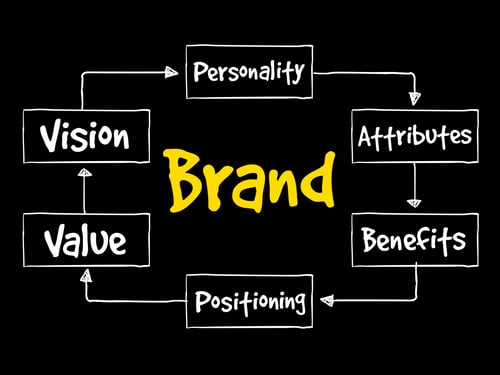
Did you know that highly engaged employees are 87% less likely to leave their companies? A study of 64 organizations revealed [1]:
- Organizations with highly engaged employees earned twice the annual net income compared to those whose employees lag on engagement.
- 70% of U.S. workers are not engaged at work.
- Companies with engaged employee’s enjoy 2.5 times more revenue for vs. competitors with low engagement levels.
Employee brand engagement is the process by which a company shapes its employees' everyday work behavior to ensure that it is consistent with the organization's brand identity. Importantly, this should not be confused with employer branding, which describes how companies influence the external perceptions of their brands from a workplace perspective. Employer branding is most often used in recruiting efforts as a means to attract top-notch talent. Conversely, employee brand engagement focuses less on prospective employees and more on those already in the building.
Internal audiences (namely employees) are equally important to successful brand-building as external constituencies (e.g., customers).
Employee brand engagement focuses internally on addressing how companies should consistently recruit, train, communicate with, and incentivize employees in a way consistent with the brand strategy. The corporate brand resides at the intersection of these two concepts, informing both as they pursue disparate (yet related) strategies for different audiences.
According to BrandingBusiness, a brand strategy agency dedicated to building B2B brands, "A successful brand launch is not possible if the brand is not first successfully launched internally. Gaining employee buy-in and ensuring every individual in the organization understands how they can live the brand is key to building a powerful brand. Companies need to pay as much attention to their internal audiences as they do to their external constituents."
The benefits of employee brand engagement are well documented. One Gallup study found that companies with highly engaged employees have earnings per share that outperform those of companies in the same industry with less engaged employees by 147%.
Employee brand engagement consists of two related components: The people component includes audiences and facilitators. The content and process component consists of the materials and activities that comprise the overall initiative.
People
By people, we mean both the people within the organization who need to be engaged (i.e., audiences) and the people best suited to lead that effort (i.e., facilitators).
Audiences. Who are the people organizations need to engage in brand education? Some companies mistakenly believe that only their frontline employees (e.g., sales representatives and customer service teams) need onboarding and training in brand strategy delivery. However, digital activation and social media have turned employees from every business function into customer-facing roles. Employees across all functions must understand and embrace brand strategy if the effort is to succeed.
Other companies have used similar tactics. General Electric, for example, invited its 350,000 employees to participate in a brand ambassador program to train its workforce on how to represent the brand both at work and off the clock.
Facilitators. The second factor in the people component, facilitators, refers to those within the company responsible for communicating the brand strategy. Should this be representatives from HR? Perhaps the CMO, or even the CEO? To be sure, leaders within both marketing and HR play vital roles in this effort. However, without visible and broad-based C-suite support, the message may ring hollow.
However, senior-level management is only part of the solution for spreading the word. Leaders must communicate the message and learn to identify, nurture, and leverage brand champions within their organizations. As the name implies, brand champions are employees who understand, embrace, and behave in accordance with the brand. Their collective influence is second only to the C-suite in its ability to help others buy into the brand strategy.
So how do you find these individuals? You can start by looking at employees' social media activity. According to Weber Shandwick and KRC Research, 39% of employees have shared praise or positive comments online about their employers. Additionally, the research shows that 21% of employees fall into an "activist" category. These workers voluntarily take positive actions (and no negative actions) regarding their employers, including but not limited to defending and advocating for the brand online.
Social media offers leaders an avenue to find and recruit brand champions, but other creative options also exist. Leaders should seek to find these brand advocates wherever they can and give them the recognition and resources they need to spread the word.
Human Resources. HR plays an important, unique role in employee brand engagement. Brands have values, and employees should embody those values. As such, companies need formal mechanisms in place to assess brand fit among both existing and potential new employees. HR must determine to what extent a prospective new employee appears to represent corporate (or business unit) brand values, and therefore, the organization.
According to Paul Barton, author of Maximizing Internal Communication, "Authentic brands are built from the inside out, and effective internal communication is crucial to branding success. I believe the best way to build an authentic brand starts with hiring people who already embody some of the brand's characteristics and then reinforcing the brand through training, appropriate policies, and ongoing internal communication."
In practice, the role of HR in employee engagement can take many forms. When Dell decided to infuse more branding into its hiring process, the company turned to its internal agency, Dell Blue, to develop a campaign that hit job listings, social platforms, and events. Dell ensured that every employee, future and present, received proper training on how to embody the company brand.
Content and Process
The second component of employee brand engagement relates to the activities used to facilitate the engagement. Unfortunately, these activities are often superficial at best. The marketing department issues a memo outlining the brand strategy, distributes posters and mousepads containing key brand messages and calls it a day. Slightly more ambitious companies may go a step further to include a limited round of employee training. While these are worthy tactics, an employee brand engagement initiative needs to be a formal, strategic, ongoing effort to succeed long-term.
Let's break down content and process in greater detail.
Content. One content tool to consider is brand stories which are an important component of any brand strategy. Done well, they endear customers and other external stakeholders to the brand, but they also can be effective internally by educating and engaging employees on brand strategy.
In a post for Content Marketing Institute, Carla Johnson, chief experience officer at Type A Communications and author of Experiences: The 7th Era of Marketing, discussed how Motorola Solutions leveraged the power of brand story in employee engagement. When Motorola split into two separate companies, employees eventually found themselves working for new employers when the realignment finished. Rather than assume employees would get the gist, Motorola rebranded more than 30 locations over the weekend, celebrating the new brand promise and helping employees understand what that promise entailed.
Motorola Solutions articulated its brand purpose: helping people be their best in the moments that matter. They used the brand purpose as the foundation that led to leadership actions and storytelling that inspired employees. This built deep engagement for employees by explaining how the company was transitioning from discussing the products they sell to talking about the meaningful difference they provide. For example, instead of talking about the technical specifications of the handsets they sell to police departments, they told the story of what they enable police officers to do—save lives.
Another tool, employee value proposition, has been gaining favor in recent years. As the name implies, employee value proposition is like a brand positioning, or value proposition, except it focuses exclusively on an internal audience. Importantly, brands must tightly link this value proposition and the external one or risk creating a disjointed brand.
Social media management platform Hootsuite provides an excellent example of an employee brand value proposition. The company's blog proclaims, "At Hootsuite, we're revolutionizing communications via social and transforming messages into meaningful relationships. Our team is comprised of passionate, egoless peeps having fun building something bigger than themselves. Each day, you will bring our core values to life through your actions and collaboration with our team, our customers, and our community." Hootsuite's employee value proposition effectively conveys the brand's essence to employees, helping them understand their high-level role in delivering that brand to external audiences.
The last employee branding tool is the brand playbook. More than a mere style guide—which outlines how the brand should be presented visually and in text—the brand playbook establishes guidelines for how employees should present the brand holistically. This includes details on procedures, processes, and rules covering what it means to live the brand. Among other things, an effective brand playbook clearly delineates the types of activities and behaviors consistent with the brand strategy and which are not. Hootsuite built an entire library of branding for this purpose, which resulted in a 50% increase in qualified job applicants.
The brand playbook includes the employee value proposition, but that's not all. It also provides directives for how employees should act in accordance with brand guidelines in every situation, from face-to-face interactions to social media communications.
Process. In terms of the processes and activities brands can use to deliver content to employees, options are virtually limitless. Townhall meetings, offsite company functions, and formal training sessions are traditional avenues. However, today's digital landscape provides companies with a variety of other options for activation channels, including company intranet, YouTube videos, and social media sites (both internal and public).
It's helpful to think about process as an ongoing effort rather than a solo event or moment in time. As with external audiences, employees need repetition and continuity to absorb complex concepts and messages. To get those messages to stick, they should be exposed to consistent messages over time, ideally in new and creative manners. New employees will always need onboarding, so companies should use that time as the outset.
The content and processes of employee brand engagement turn good ideas into reality. By understanding the roles these tools play, companies can get their employees on board and excited about their brands.
Employee Brand Engagement Deserves the Spotlight
Employee brand engagement is a critical yet often overlooked aspect of brand strategy. As marketers, we are trained to take an outside-in approach. Market research and other efforts help us gain a deep understanding of the wants, needs, attitudes, and perceptions of customers and other external stakeholders. We use that information to develop outward-looking brand strategies. This is certainly a best practice that we should maintain, but just because it's necessary doesn't make it sufficient.
No brand strategy—no matter how compelling or unique—can succeed in the long run if it is not understood, embraced, and lived by the employees who are responsible for its delivery. This includes all employees, not just marketing or customer service departments. When companies develop entire workforces of people committed to their brands, they can achieve things far beyond the reach of companies that fail to turn that branding focus on themselves.
Source:
[1] https://www.themuse.com/advice/10-shocking-stats-about-employee-engagement
Recent Posts
Posts by Topics
- Brand Strategy (57)
- Brand Strategy Consulting (28)
- Brand Differentiation (27)
- Customer Experience (24)
- Brand Positioning (22)
- Marketing Strategy (9)
- Brand Extension Strategy (8)
- Customer Behavior (8)
- Brand Architecture Strategy (7)
- Brand Extension (7)
- Brand Growth (7)
- Brand Portfolio & Architecture (7)
- Brand Purpose (7)
- Brand Value Proposition (7)
- Brand Engagement (6)
- Brand Portfolio Strategy (6)
- Brand Storytelling (6)
- Rebranding Strategy (6)
- Brand Awareness (5)
- Brand Image (5)
- Branding (5)
- Rebranding (5)
- Technology (5)
- B2B Brand Strategy (4)
- Brand Experience (4)
- Value Proposition (4)
- Brand Extendibility (3)
- Brand Metrics (3)
- Brand Repositioning (3)
- Corporate Branding (3)
- Differentiation Strategy (3)
- Measurement & Metrics (3)
- Brand Engagement Strategy (2)
- Brand Portfolio (2)
- Brand Promise (2)
- Brand Voice (2)
- Digital Marketing (2)
- Digital and Brand Experience (2)
- Employee Brand Engagement (2)
- Brand Architecture (1)
- Brand Development (1)
- Brand Equity (1)
- Brand Identity (1)
- Brand Measurement (1)
- Brand Name (1)
- Brand Strategy Consultants (1)
- Brand Strategy Firms (1)
- Digital Strategy (1)
- Internal Branding (1)
- Messaging (1)


